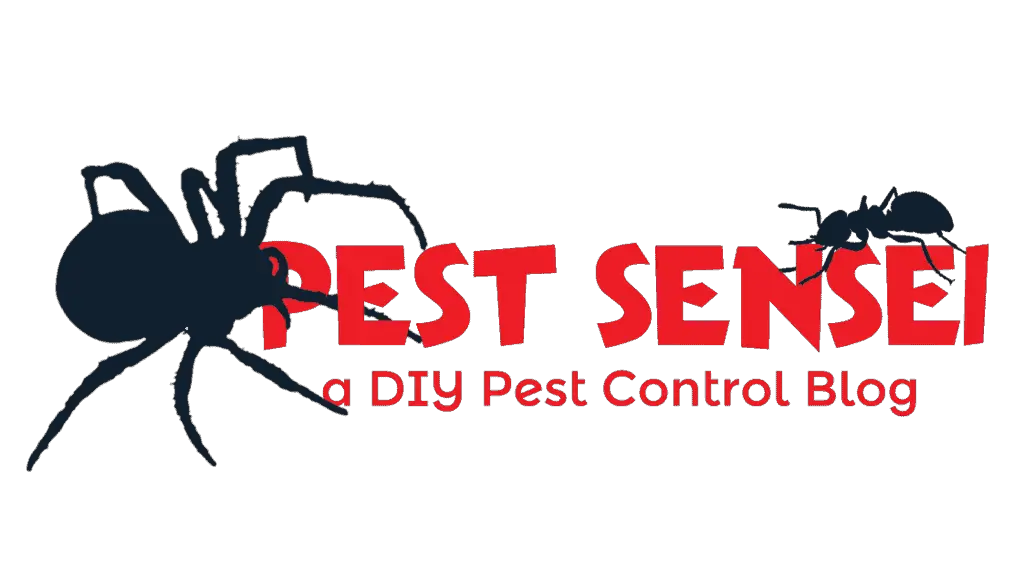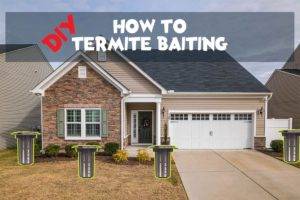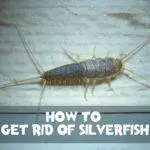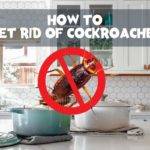Termite baiting is arguably the most effective way to eliminate a termite colony. With some knowledge in termite behavior, DIY termite baiting is easy. Here, I will teach you all you need to know about termite baiting and how to DIY termite baiting.
Is Termite Baiting Effective?
Termite baiting is effective, for as long as you know what you are doing. Achieving effective termite control through baiting requires some understanding of the termite behaviors and a considerable amount of patience.
Patience plays a crucial role when using termite bait, particularly in the context of an existing termite infestation at your residence. It is essential to be aware that visible reductions in termite activity may take a significant amount of time, and it may be months before the termite colony is entirely eradicated.
Given the gradual nature of the baiting process, some individuals may hastily dismiss its effectiveness. Their perspective centers solely on the ongoing termite feeding rather than observing the desired outcome of termite mortality. However, it is imperative to delve deeper into the mechanics of termite bait to comprehend its efficacy fully.
How Termite Bait Works?
Termite bait works by capitalizing exploiting termite behavior called trophallaxis, where the workers transfer food through mouth-to-mouth or mouth-to-anus contact. This behavior allows slow-acting baits to be spread across the colony, even to those termites not involved in foraging the bait.
Termite bait is a clever combination of highly appealing cellulose infused with termiticide. Each manufacturer employs their distinct formulation, aiming to make their bait matrix exceptionally enticing compared to other wooden structures. This will entice termites to focus their feeding efforts on the bait rather than other potential food sources.
On top of a highly palatable bait matrix, the termiticide used is also important. It has to act slow enough so that the toxicant can be spread to the whole colony. If the termites carrying the bait are killed before the bait can be passed around, the bait fails its mission.
The majority of termite baits available in the market incorporate slow-acting chitin synthesis inhibitors (CSI). These inhibitors only exert their lethal effects during termite molting by disrupting the formation of chitin, a crucial component in the termites’ exoskeleton.
Termites undergo a process called incomplete metamorphosis. It begins with the queen laying eggs, which then hatch into nymphs. Nymphs have the potential to molt into various castes, such as workers, soldiers, or alates. On the other hand, mature termites like the queen, alates, soldiers, and workers do not undergo molting.
CSI targets and eliminates molting individuals, which are the nymphs. As workers and soldiers age and perish, the lack of sufficient nymphs to replace them causes a drastic reduction in the colony’s workforce.
Over time, the colony faces collapse as the scarcity of termites impedes crucial tasks such as grooming the queen and her young, foraging for food and water, nest repairs, constructing mud tubes, and defending the colony.
Since the termite queen depends on her army for survival, her demise becomes inevitable without the support and protection of her diminished forces.
Is Termite Baiting Safe?
Termite baiting is the safest termite treatment. The active ingredients used are low toxic to humans, fish, birds, and mammals.
Moreover, the chemicals are contained in cartridges, accessible only by termites. It has a very low risk to the environment, non-target animals, and the applicators.
Can I Bait Any Termites?
Unfortunately, termite baits exclusively target subterranean termites, more specifically lower termites. They do not demonstrate effectiveness against drywood, dampwood, or higher termites. The reason lies in their distinct biology, contrasting behavior patterns, and varying food preferences.
Now, how can you determine if your termite infestation is susceptible to baiting? Look for a soldier termite, identifiable by its larger head capsule and formidable jaws. Attempt to disturb it using a screwdriver or pen. As a general guideline, if the soldier releases a whitish fluid when disturbed, it is a lower termite, indicating a potential responsiveness to baiting.
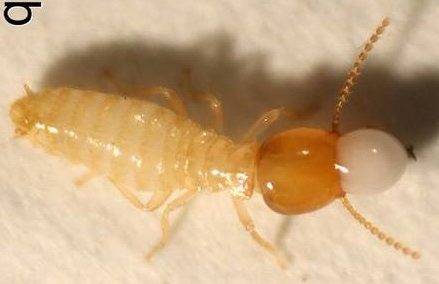
In-Ground Termite Baiting
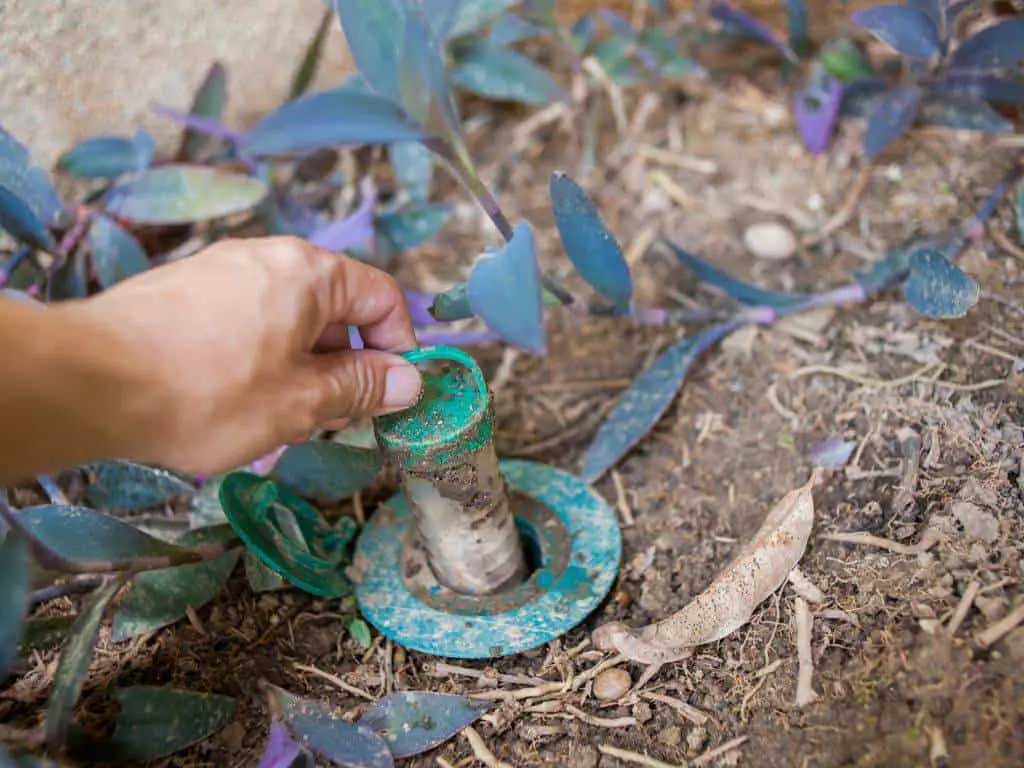
In-ground bait stations serve as strategically buried stations within the soil surrounding your property. Their purpose is to detect and intercept invading termites. When termites encounter the bait, they are enticed to consume it, ultimately resulting in the elimination of the termite colony.
Think of these stations as a network of scattered landmines around your house. Any invaders stepping on these landmines meet their demise. However, there is a possibility that some fortunate invaders manage to avoid the landmines and reach your doorstep.
In-ground bait stations operate with a similar principle. There remains a chance that termites may bypass the bait stations altogether and gain direct access to your home.
To enhance the effectiveness of your in-ground termite baiting system, it is crucial to install a greater number of stations at a higher density. This helps to maximize the chances of interception and bait consumption.
It is important to note that in-ground bait stations alone cannot eradicate an existing termite infestation. You must address and eliminate those termites through spraying.
In most cases, highly enticing woods without termiticide are initially placed in the bait station. Only upon detection of termite activity, the appropriate termite baits are introduced into the active station. This approach contributes to long-term cost savings while still effectively addressing the termite issue.
Trelona Advance Termite Bait System
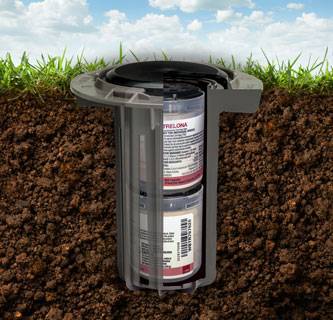
I recommend using the Trelona Advance Termite Bait System. This system comes with bait stations, wood, inspection cartridges, the bait cartridges, and a tool to open up the bait station.
The bait cartridge contains Novaluron, a slow-acting chitin synthesis inhibitor that kills molting termites.
Like other in-ground baiting systems, woods (called the monitoring base) and inspection cartridge are placed in the bait station to lure termites. Once termites are detected, the inspection cartridge can be easily replaced with a bait cartridge.
How to Install In-Ground Termite Bait Stations?
To install in-ground termite bait stations, you will require an auger to dig into the soil. An auger with a diameter of approximately 2.5 inches is suitable for Advance Termite Baiting Stations. It is important to ensure that the holes are not excessively wide. The bait station should touch the soil so that the termites can find it.
Using the auger, dig holes around your house, maintaining intervals of 10-20 feet between holes. The higher the density of the bait stations, the higher the chance of termites being intercepted
The hole should be approximately 2-3 inches deeper than the height of the bait station. This gap beneath the fully inserted station facilitates water drainage, thereby extending the lifespan of the wood or bait.
In cases where your house exterior features tiles or pavers, drilling through them becomes necessary for bait station installation. It might be easier to just inject termiticide into the soil under those area instead.
Carefully insert the stations into the holes until the cover is slightly above the ground level. While wearing gloves, place the wood and inspection cartridge into the stations and securely close the lid.
How to Service In-Ground Termite Monitoring Station?
Maintain a calendar to remind yourself to check the monitoring stations periodically. For instance, with the Trelona Advance Termite Bait System, a check every 2-4 months is recommended. Shorter intervals enable prompt baiting if any infestation is detected.
If you observe any termite infestation within the bait station, you have hit the jackpot. In the case of the Advance Termite Bait System, carefully remove the inspection cartridge. Replace it with the bait cartridge, and securely close the lid.
Every two months, inspect the active station. If the bait is nearly depleted, replace it with a fresh bait cartridge. Repeat this process until there are no more termites present in the infested station or only soldier termites are visible. The presence of only soldier termites indicates the termite colony has been suppressed, and will eventually collapse since there are no more workers.
Once the infestation is under control, introduce new wood and an inspection cartridge to the station.
Regularly replace the wood and inspection cartridge in accordance with the manufacturer’s instructions or when signs of mold emerge, whichever comes first.
Tips on Handling Baits
When working with termite baits, it is essential to follow these tips for optimal results.
Always wear gloves when handling bait. Termites are sensitive to odor. Wearing gloves can prevent the undesirable odor from being transferred to the wood and cartridge. This is important, especially if you smoke.
Don’t kill any termites in the bait stations. When replacing the cartridge, exercise caution. Carefully place the empty cartridge, along with any termites on it, into a tray. Insert a new cartridge, and then return all the termites from the tray back into the station. Termites have a tendency to abandon the bait station if their nestmates are killed in the bait station.
Avoid spraying any chemicals around the bait station, even if they are non-repellent. Termiticide sprays can expedite termite mortality before they have a chance to share the ingested bait with their nestmates. This defeats the purpose of baiting.
Address bait stations that become infested by ants. Ants are natural adversaries of termites, and termites will instinctively avoid stations with ant presence. Temporarily remove the ant-infested station, allowing the ants to go away.
Minimize disturbances to termites once they begin feeding. Once the termites initiate their feeding process, it is advisable to leave them undisturbed as they dislike disruptions. If inspections are necessary, handle them gently so that the termites do not abandon the bait station.
Above Ground Termite Baits
Unlike in-ground baiting methods, above ground (AG) bait stations offer a practical solution for sites experiencing active subterranean termite infestations. This approach proves to be the most cost-effective method for termite eradication, as the bait is strategically placed adjacent to the termite trail, providing a highly targeted approach.
However, it is important to note that above-ground termite baiting does not serve as a preventive measure against future infestations.
Unfortunately, there are no DIY above ground termite baits available for the retail market. If you happen to come across any above ground termite bait options, kindly leave a comment, and I will expand this section to include valuable tips and tricks based on my experience with above-ground baiting techniques.
If you opt to enlist the assistance of a pest management professional to address active termite infestations in your home, AG baiting offers the best value for your investment. You can obtain non-obligatory quotes from local exterminators through Networx.
Can I Create My Own DIY Termite Bait?
Technically, you can create your own DIY termite bait by impregnating wood with termiticide. However, the challenge lies in making the bait attractive and incorporating the correct dose of termiticide.
Final Words
In-ground termite baiting shouldn’t be used alone as the only protection against termites, because there is an element of probability. You must set up the baiting system in conjunction with other proofing methods to minimize the risk of subterranean termite infestation.
I hope you find this guide helpful, and thank you for reading. Do share my blog if it helps you.
